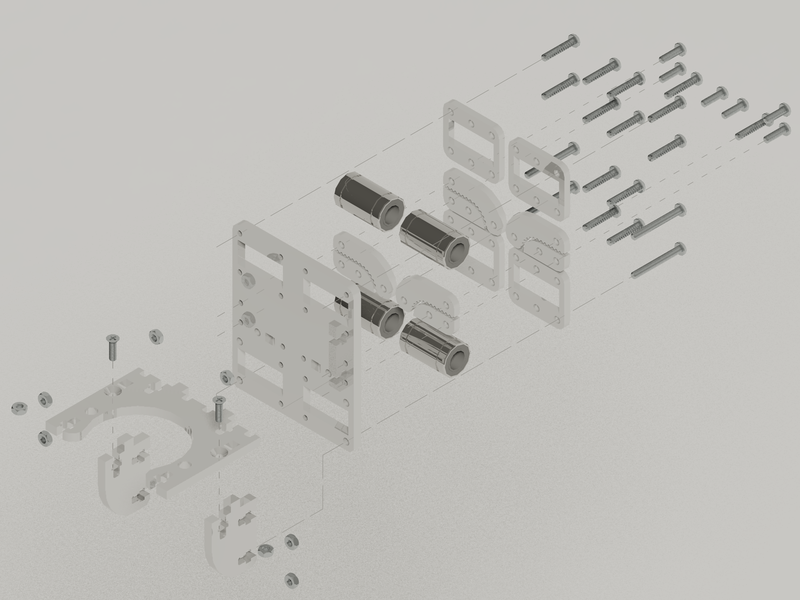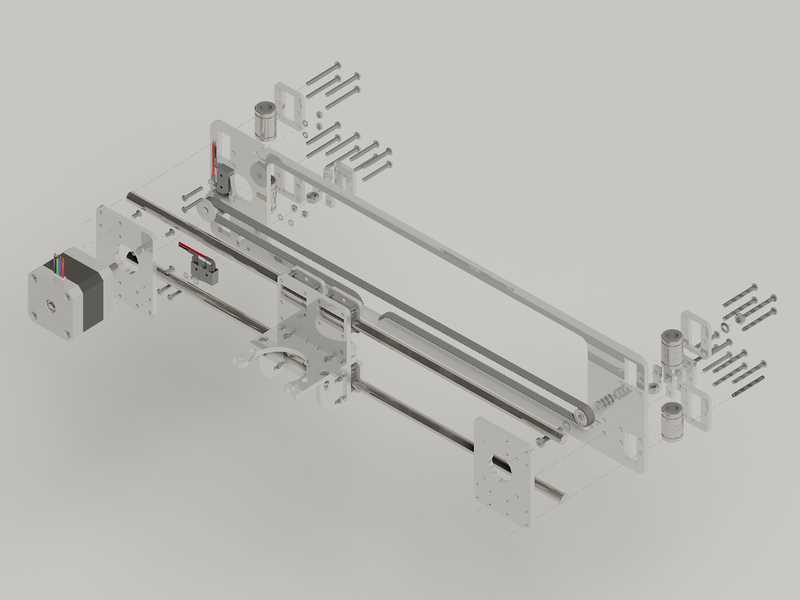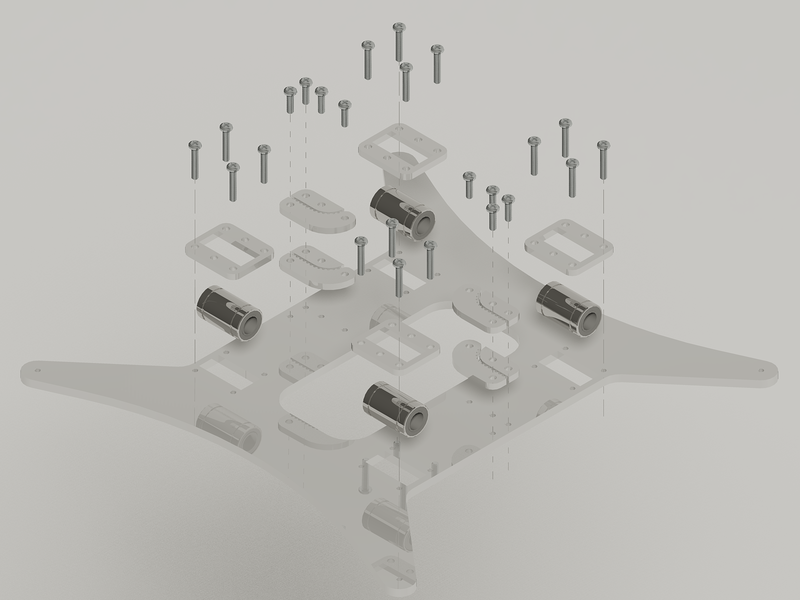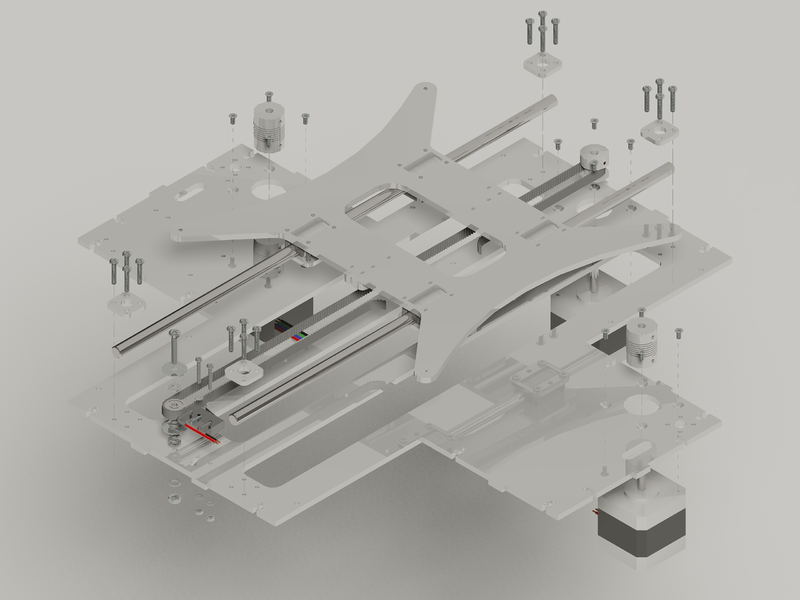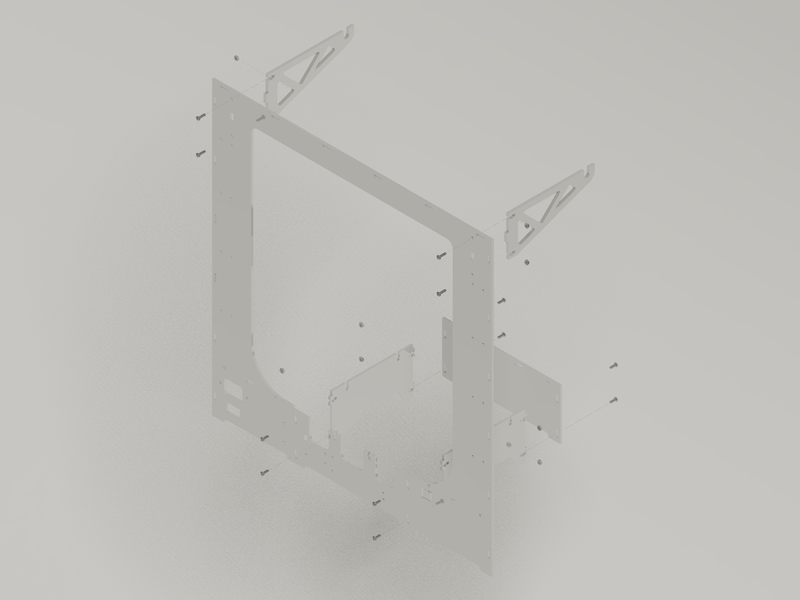This page is under construction! Sorry for inconvenience.
Introduction
Welcome on the building manual page for CARP Box 3D Printer. On following pages you will find step-by-step walktrough the construction of the printer, wiring electronics, firmware settings and calibration, so you can achieve the best performance of your printer.
Warning
Most of the pictures were taken during construction of first prototype. There are few minor changes stated in red colour against what you can see on the picture. If you are not sure what to do, please follow the text or contact me on thorgal(at)atlas(dot)cz.
During the assembly many screws are fixed directly to the threads in aluminium sheet. Tighten them carefully, as threads in aluminium can be easily damaged.
Please read the complete manual before you will even order any parts or start construction works.
Disclaimer
I am sorry for any mistakes that may appear in any documentations for the printer and would like to ask you kindly to give me a notice of any problem you will find on thorgal(at)atlas(dot)cz. Despite my genuine regret I cannot be held responsible for any loses or injuries caused by assembling or operation of the CARP BOX 3D printer.
Preparations
Whole Printer (including extruder, which is not part of this assembly manual) was designed to be made of laser cut metal sheets. Preferably 3 and 4mm thick aluminium, although steel sheet may add some sturdiness in exchange for additional weight.
Blueprint should be sufficient for any company providing laser cutting, but some of them may have difficulties to cut smaller holes than thickness of the material. In such case ask them for central hole of size of the laser beam, so you can drill them afterwards.
Even without drilling most of the parts have to be machined afterwards as many have holes with M3 a and M4 treads and holes for countersunk heads of the screws. These holes are marked in the blueprint. For all of above reasons, aluminium is easier to be machined at home with nothing more than just an electric drill.
Afterwards the edges have to be sanded. Partially to remove the excess material from laser cutting and also to make them less sharp. Only exception are mounting holes for LM8UU, which should stay as sharp edged as possible.
Eventually the printer parts may undergo a paint or some other sort of surface treatment (this manual shows raw aluminium).
Before the assembly, all parts suggested by the BoM should be collected.
Tools
- For drilling and preparing threads, electric hand driller (running both directions is required, drill press recommended).
- Drills of diameter 2.5mm, 3.2mm
- Screw taps of size M3 and M4 and tap wrench
- Countersunk bit
- Sander and sand paper
- Needle Files
- Phillips screwdriver of right size (or other, if you use different screw heads)
- Allen key of right size (for pulleys and Z spring joint)
- Pliers
- Cutter or scissors
- Tweezer (some nuts are hard to install with bare hand)
- Calliper
- Soldering Iron
Construction
Carriage
| Picture
|
Quantity
|
Description
|
Comments
|
 |
1 |
Carriage Plate |
Cutted M3 threads
|
 |
1 |
Carriage Holder |
Contrasunk holes
|
 |
2 |
Carriage Holder Support |
|
 |
4 |
Belt Holder |
|
 |
4 |
Belt Lock |
Either for GT2 or T2.5 Timing Belt
|
 |
4 |
LM8UU Bearing Holder |
|
| |
4 |
LM8UU Bearing |
|
| |
2 |
M3x10 Phillips Countersunk Screw |
|
| |
6 |
M3x10 Phillips Round-pan Screw |
|
| |
12 |
M3x16 Phillips Round-pan Screw |
|
| |
2 |
M3x20 Phillips Round-pan Screw |
|
| |
4 |
M3x25 Phillips Round-pan Screw |
|
| |
8 |
M3 Hex Nut |
|
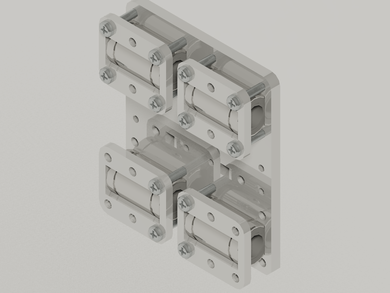 Place LM8UUs on back side of the carriage plate and fasten them with 12pcs of M3x16 round-pan screws. Bottom holders will have screws only in the centre holes. Outer holes will stay empty, distance between Carriage plate and LM8UU holders should be 9-9.5mm. |
 Put 2 Belt holders on left and 2 on right side of the back side of carriage plate (big round corner facing centre upward) and tighten them with 1pc M3x10 round-pan screws in outer holes each. |
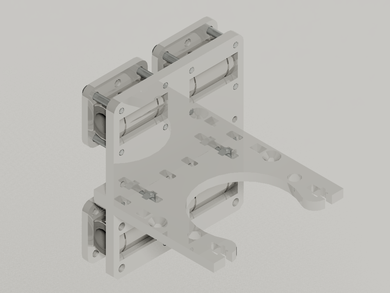 From the front side of the plate insert carriage holder with countersunk holes facing up. Through inner holes of belt holders put 2pcs M3x20 round-pan screws. insert 2pcs of M3 hex nuts into holes in carriage holder and tighten them together. |
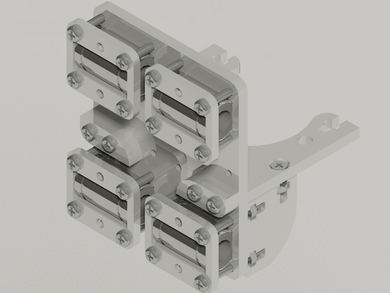 Put 2 supports on each side of the carriage. Their locks should fit into carriage holder. Tighten Carriage holder with supports by 2pcs of M3x10 Countersunk screws against M3 hex nuts in supports. Now put 4pcs M3x25 round-pan screws through outer holes of bottom LM8UU holders and tighten them against M3 hex nuts inserted in supports. |
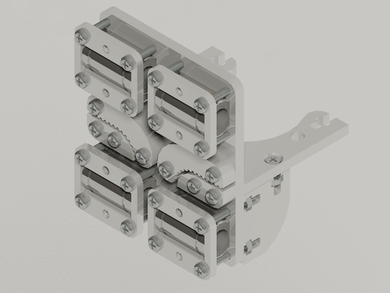 Put 2 GT2 or T2.5 Belt lock on left and 2 on right side of the back side of plate (L shape around belt holders) and tighten each with 2pc M3x10 round-pan screws. |
X Axis Frame
| Picture
|
Quantity
|
Description
|
Comments
|
 |
1 |
X Axis Frame |
Cutted M4 thread
|
 |
2 |
Motor Holder |
Left and Right version, Contrasunk holes
|
 |
2 |
Nut Holder |
|
 |
8 |
Nut Distance |
|
 |
4 |
LM8UU Bearing Holder |
|
| |
4 |
LM8UU Bearing |
|
| |
1 |
624ZZ Bearing |
|
| |
2 |
8mm Dia. Stainless Steel Smooth Rod 406mm Long |
The length may wary from ca. 400mm up to 406mm
|
| |
1 |
GT2 Timing Belt 750mm Long, 5-6mm wide |
Can be T2.5, The length may wary from ca. 740mm up to 760mm
|
| |
1 |
GT2 20 teeth pulley |
If used T2.5 timing belt, use T2.5 pulley with 16 teeth.
|
| |
1 |
NEMA 17 Stepper Motor (Bipolar), 40mm long |
Length of the cable ca. 600mm with 4pin plug
|
| |
2 |
Microswitch (2x 2.5mm hole, 11mm apart) |
Ca. 600mm long cable with 2pin plug
|
| |
4 |
M2.5x16 Phillips Round-pan Screw |
|
| |
4 |
M2.5 Hex Nut |
|
| |
8 |
M2.5 Washer |
|
| |
4 |
M3x8 Phillips Countersunk Screw |
|
| |
8 |
M3x25 Phillips Round-pan Screw |
|
| |
16 |
M3x30 Phillips Round-pan Screw |
One should be shortened to length 27mm
|
| |
1 |
M4x20 Phillips Round-pan Screw |
|
| |
1 |
M4 Hex Nut |
|
| |
6 |
M4 Washer |
|
| |
2 |
M5 Hex Nut |
|
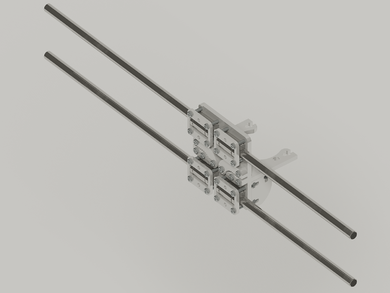 Insert smooth rods into preassembled carriage. |
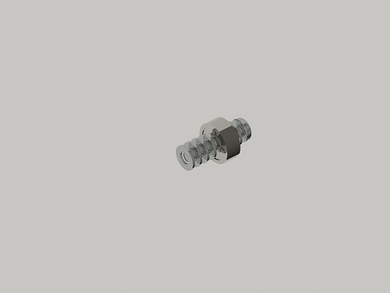 Prepare M4x20 round pan screw with 624ZZ bearing. Under the bearing should be washers of approximate height 2mm (ca 4pcs). One more washer under the screw head. |
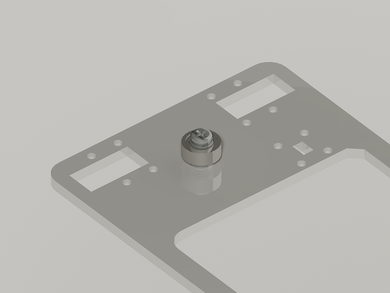 Install the screw on the front right side of X axis frame. Tighten the screw with M4 hex nut and washer from the wrong side of the frame |
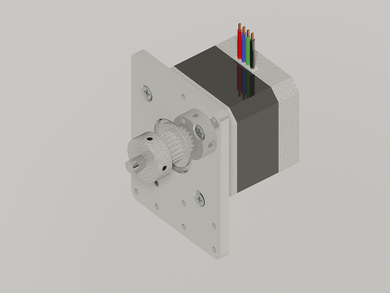 With 4 M3x8 countersunk screws attach NEMA 17 stepper motor to motor holder. Tighten GT2 (T2.5) pulley on the motor shaft so the teeth begin just above the motor holder plate. Motor should be facing wires upward. |
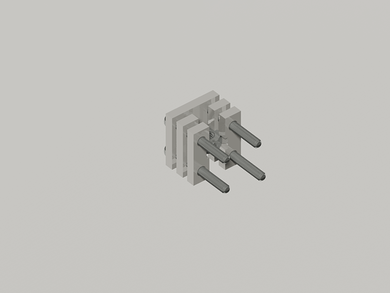 Prepare housing for M5 hex nut made of one holder and two distance pieces on each side. Pull M3x25 Round pan screws trough the holes. Insert M5 hex nut in the centre opening. |
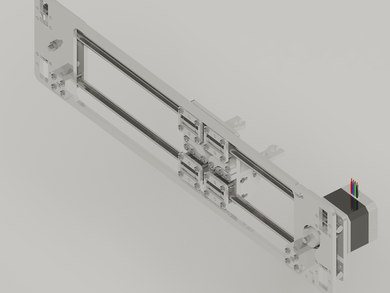 From the back side of the X axis frame push through the mounting holes screws of the M5 nut housings. Place carriage with smooth rods on the front side of the frame so the bottom rod is sitting in between the screws. Carriage holder facing to the front. Place motor holder with Motor on the front left side, and empty motor holder on the Front right side. Tighten the screws. |
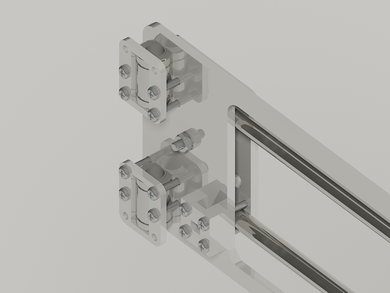 Put LM8UU into the LM8UU holder and insert four M3x30 round pan screws into the holder. The screws should go through X axis frame around smooth rods to the motor holder. Secure the top rod first. |
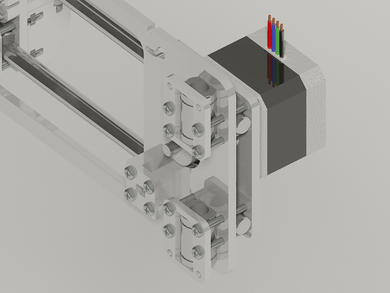 Same on the other side. One threaded rod is under the motor, this screw should have only 27mm long thread! As 27mm is not a typical metric screw size, you will have to cut it and sand it first. |
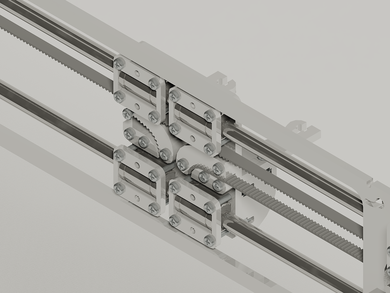 Open both belt locks on sides of the carriage (as you can see on the left side). Secure the belt on one side and put it around the pulley and 624ZZ bearing. |
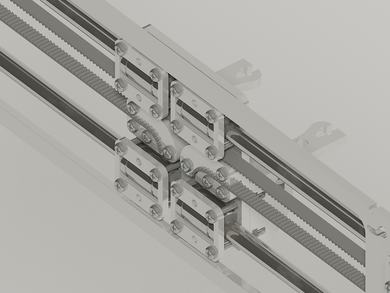 Stretch the belt and secure the other side of the timing belt with the lock. |
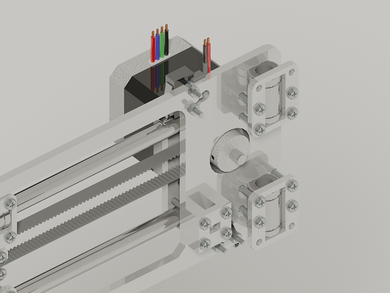 Install endstop microswitches with soldered wires from the front side of the x axis frame. Put M2.5x16 screws with washer trough holes in the microswitches. Tighten them from the back side of the frame with M2.5 washers and hex nuts. The lever should face down to the rod on the X axis (upper switch). |
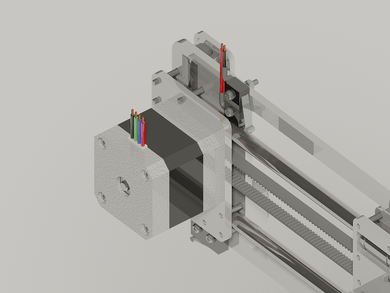 The bottom endstop is for the Z axis and the lever should face out. One screw of the microswitch is fixed, the other can be used to set switching distance. |
Top Plate
| Picture
|
Quantity
|
Description
|
Comments
|
 |
1 |
Top Plate |
Cutted M3 threads
|
 |
2 |
608ZZ Bearing Holder |
|
 |
2 |
Rod Holder |
|
| |
2 |
608ZZ Bearing |
|
| |
8 |
M3x10 Phillips Round-pan Screw |
|
| |
6 |
M3x16 Phillips Round-pan Screw |
|
| |
2 |
M5x350 Threaded Rod |
|
| |
4 |
M5 Hex Nut |
|
| |
4 |
M5 Washer |
|
| |
2 |
8mm Dia. Stainless Steel Smooth Rod 380mm Long |
The length may wary from ca. 375mm up to 435mm
|
| |
2 |
8mm Inner Dia.x 2mm Thick Rubber Gasket |
7mm Inner Dia. may work as well
|
| |
2 |
5mm Inner Dia./ 8mm Outer Dia. PVC Hose 8mm Long |
Can be replaced by silicon or rubber tube
|
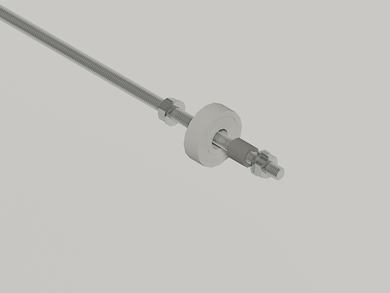 Place M5 hex nut, M5 washer, ca. 8mm long piece of 5/8 PVC tube, 608ZZ bearing, M5 washer and M5 hex nut on one end of each M5 threaded rod. |
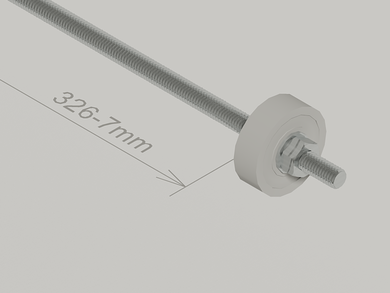 Tighten the whole set so bearing is ca. 326-327mm from one end of the M5 threaded rod. Tighten it strongly so the washers will touch the bearing from both sides. The X axis frame will hold on these bearings. The PVC tube should fill the bearing and centre the rod. |
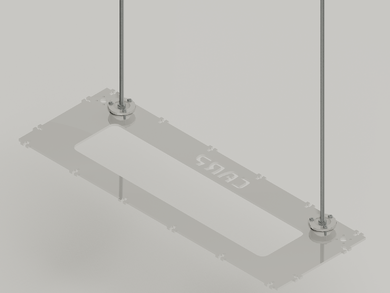 Place the two sets on wrong side of the top plate and attach them with 608ZZ bearing holders and 3 pcs M3x16 round-pan screws each. |
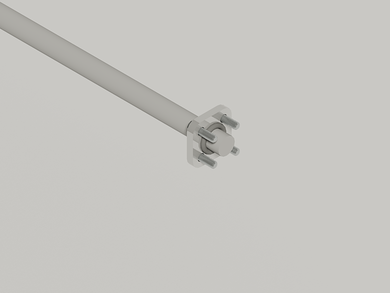 Put rod holders and rubber gaskets on one end of both smooth rods. The hole is made exactly 8mm Dia. If you have got difficulties to put the rod through, twist it a bit. |
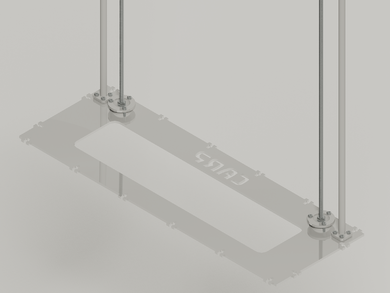 Attach smooth rod to the wrong side of the top plate with 4 pcs of M3x10 round-pan screws each. Smooth rod should protrude to the front side of the plate ca. 3mm. Tighten the screws very carefully, only so much that the smooth rod is barely moving. It is not necessary to make the rubber gasket almost flat. |
Frog
| Picture
|
Quantity
|
Description
|
Comments
|
 |
1 |
Carriage Plate |
Cutted M3 threads
|
 |
4 |
Belt Holder |
|
 |
4 |
Belt Lock |
Either for GT2 or T2.5 Timing Belt
|
 |
4 |
LM8UU Bearing Holder |
|
| |
4 |
LM8UU Bearing |
|
| |
8 |
M3x10 Phillips Round-pan Screw |
|
| |
16 |
M3x16 Phillips Round-pan Screw |
|
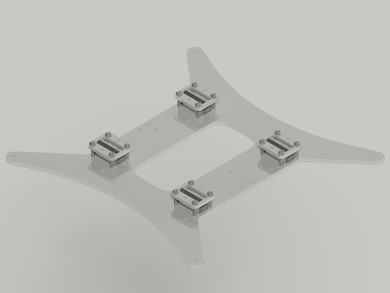 Place LM8UUs on back side of the frog plate and fasten them with 16pcs of M3x16 round-pan screws. Distance between Carriage plate and LM8UU holders should be 9-9.5mm. |
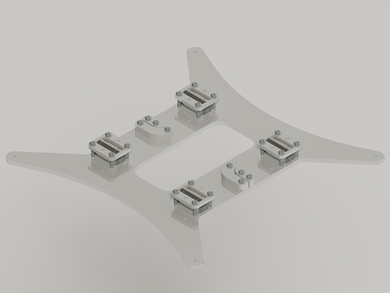 Put 2 Belt holders and belt locks on left and 2 on right side of the back side of frog plate and tighten them with 8pc M3x10 round-pan screws. |
Y Axis Frame
| Picture
|
Quantity
|
Description
|
Comments
|
 |
1 |
Y Axis Frame |
Cutted M3 and M4 thread, Contrasunk holes
|
 |
4 |
Rod Holder |
|
| |
1 |
624ZZ Bearing |
|
| |
2 |
8mm Dia. Stainless Steel Smooth Rod 374mm Long |
The length may wary from ca. 374mm up to 390mm
|
| |
1 |
GT2 Timing Belt 715mm Long, 5-6mm wide |
Can be T2.5, The length may wary from ca. 705mm up to 725mm
|
| |
1 |
GT2 20 teeth pulley |
If used T2.5 timing belt, use T2.5 pulley with 16 teeth.
|
| |
2 |
5/5mm Z Spring Joint |
|
| |
3 |
NEMA 17 Stepper Motor (Bipolar), 40mm long |
Length of the cable ca. 600mm with 4pin plug
|
| |
1 |
Microswitch (2x 2.5mm hole, 11mm apart) |
Ca. 600mm long cable with 2pin plug
|
| |
2 |
M2.5x16 Phillips Round-pan Screw |
|
| |
2 |
M2.5 Hex Nut |
|
| |
4 |
M2.5 Washer |
|
| |
12 |
M3x8 Phillips Countersunk Screw |
|
| |
16 |
M3x16 Phillips Round-pan Screw |
|
| |
1 |
M4x20 Phillips Round-pan Screw |
|
| |
1 |
M4 Hex Nut |
|
| |
5 |
M4 Washer |
|
| |
2 |
M4 Mudgard Washer |
Atleast 16mm outer dia. You can use washers up to M6 instead
|
 Insert smooth rods into preassembled frog. |
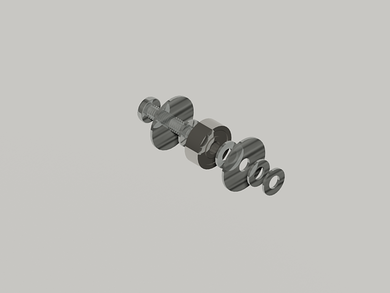 Prepare M4x20 round pan screw with 624ZZ bearing. Around the bearing should be M4 washers and M4 mudgard washers, so the timing belt won't slide down. Under the bottom mudgard washer should be 1.5mm distance to Y axis frame (ca 2pcs of washers). |
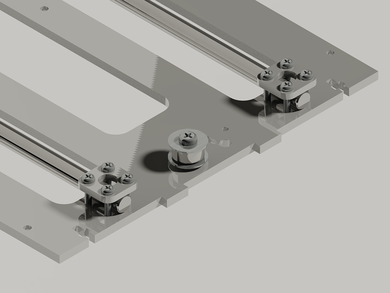 Install the M4 screw with bearing in the front side of Y axis frame. Tighten the screw with M4 hex nut and washer from the wrong side of the frame. Place the frog with smooth rods on the front side of the Y axis frame. Tighten the rods with rod holder and 4 pcs M3x16 round pan screws each. |
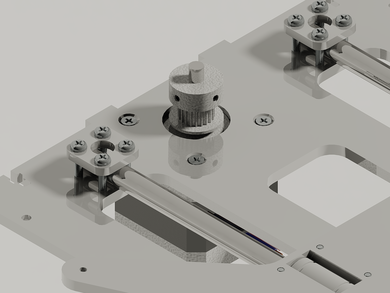 With 4 M3x8 countersunk screws attach NEMA 17 stepper motor for Y axis to the Y axis frame. Tighten GT2 (T2.5) pulley on the motor shaft so the teeth begin just above the motor holder plate. Motor should be facing wires to the centre. Also around motor the smooth roods should be tightened with rod holders and M3x16 round-pan screws. |
 With 8 M3x8 countersunk screws attach two NEMA 17 stepper motor for the Z axis to the Y axis frame. Tighten Z spring joints on the motor shafts so it is sitting on the tom 7-8 mm of the motor shaft. Motors should be facing wires to the centre. |
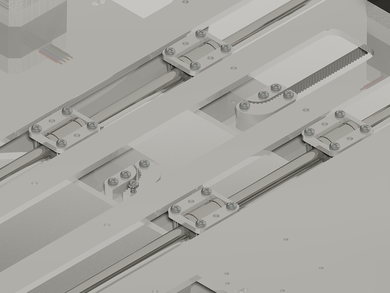 Turn the Y axis frame upside down. Open belt locks on the frog (left belt lock open on the picture). Attach timing belt into one of the belt locks. |
 Strech the timing belt and tighten the other side of the timing belt. |
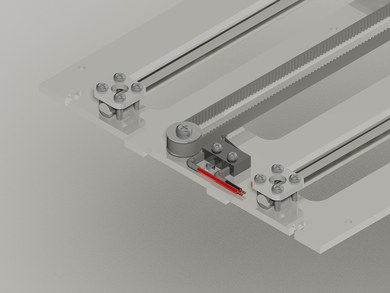 Install endstop microswitch with soldered wires from the front side of the x axis frame, close to the 624ZZ bearing. Put M2.5x16 screws with washer trough holes in the microswitche. Tighten them from the back side of the frame with M2.5 washers and hex nuts. The lever should face to the bearing. Wires should be pushed through the hole behind the endstop. |
Sides
Case
| Picture
|
Quantity
|
Description
|
Comments
|
 |
1 |
Front Case Panel |
|
 |
1 |
Rear Case Panel |
|
 |
4 |
Bottom Side Panel |
|
 |
2 |
End Panel |
|
 |
2 |
Filament Spool Holder |
|
| |
16 |
M3x8 Phillips Round-pan Screw |
|
| |
4 |
M3x10 Phillips Round-pan Screw |
|
| |
20 |
M3 Hex Nut |
|
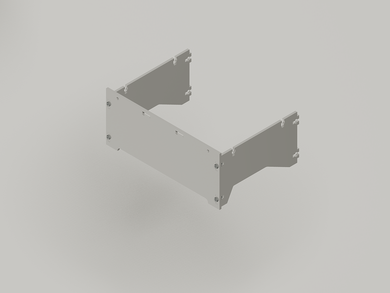 Join end panel with two bottom side panel by 4pcs M3x8 round-pan screws and 4 pcs of M3 hex nuts inserted in the locks of bottom side panels. |
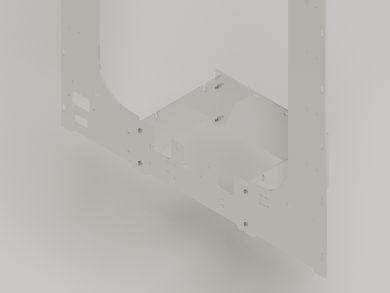 Similarly attach this to the front side of the front case panel through locks in the bottom side panels by 4 pcs of M3x8 round-pan screws and M3 hex nuts. Front side of the Front case panel is with hole for EURO connector and power switch on bottom right side. On left side is prepared hole for USB connector of Sanguinololu. If required, clean the hole for USB before assembly. |
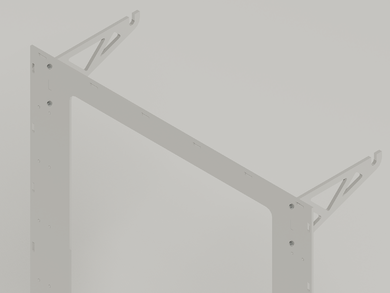 Attach filament spool holders on the front side of the front case panel by 2 pcs M3x10 round-pan screws and 2pcs of M3 hex nuts each. |
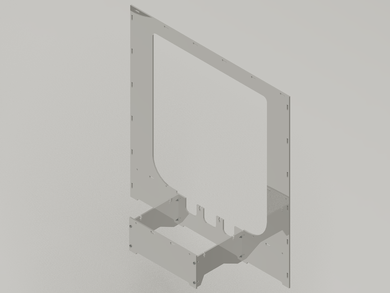 Use the same instructions for rear case panel, except for the filament spool holder which is not present. |
Heatbed
Extruder
Wiring Electronics
Stepper Motors
Endstops
Thermistors
Heatbed
Extruder
Fans
Main Power Supply
Power Cables
Display
Cable Ties
Calibration
Firmware
Steps Calculations
Endstops And Directions
Print Size
Thermistors
Uploading Firmware
Power On
Speeds And Stepper Drivers
Start Position
Temperature Control
Extrusion
Test Print
Final Adjustments
Setting Printer Profile
